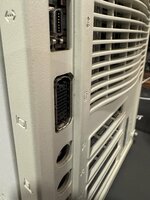A diode from pin 10 (SENSE2) to pin 7 (SENSE1) with ground on pin 4 (SENSE0) is for MultiScan 21" displays.Ah, no, you don't need anything other than some traces and a single diode to adapt from PowerMac video to VGA. The adapters with switches are only needed for older macs, and even they just have like, two diodes in them, unless you're messing with sync and auto detection. Here is the required circuit:
VGA uses a wire instead of a diode between SENSE2 and SENSE1 with SENSE0 not connected.
#41 #42
VGA and MultiSync 21" are probably the two best choices for an adapter since they give the widest range of display modes.
They may have a slightly different list of default modes but it depends on the graphics controller and its drivers. A program like SwitchRes may be able to enable non-default modes.
The 21" list of modes includes some Mac specific modes. The VGA list includes PC specific modes.
You can check the list of modes using an emulator like DingusPPC which allows specifying the Apple sense code for the display. Does the Power Mac 6100 graphics driver read EDID? DingusPPC needs more work regarding EDID reading. DingusPPC only emulates the default graphics controller of the Power Mac 6100 which is missing the higher resolutions (1024 x 768 and higher).
Code:
VGA
640 x 480 60 Hz
640 x 480 120 Hz
800 x 600 60 Hz
800 x 600 72 Hz
800 x 600 75 Hz
1024 x 768 60 Hz
1024 x 768 70 Hz
1024 x 768 75 Hz
1280 x 960 75 Hz
1280 x 1024 75 Hz
Multiscan 21"
640 x 480 67 Hz
640 x 480 120 Hz
832 x 624 75 Hz
1024 x 768 74.9Hz
1152 x 870 75 Hz
1280 x 960 75 Hz
1280 x 1024 75 Hz
